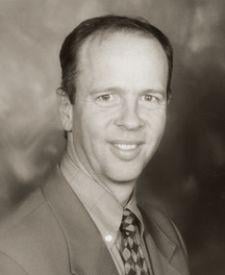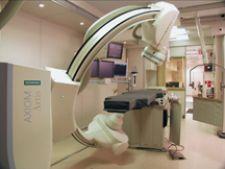
Russ Johnson
When Russ Johnson looks out the windows of San Luis Valley Regional Medical Center he surveys an area of unmatched beauty and natural wonder. His six-county domain in Colorado, southwest of Pueblo, is the size of six states each the size of New Jersey — yet home to fewer than 50,000.
What he wants for Christmas is a cath lab he can call his own.
“We are a community of 47,000 people, and that’s like a medium sized city,” said Johnson, chief executive officer of the medical center in Alamosa. “Most cities that size have a cath lab. We have to send our patients who need diagnostic cardiac work more than two and a half hours by car or by air ambulance to get them catheterized and diagnosed.”
His office sits smack dab in the center of the San Luis Valley — the highest, largest mountain desert in North America. To his east is the Great Sand Dunes National Monument and the Sangre de Cristo Mountains; to the west are the San Juan Mountains; in the valley are towns like San Luis, Alamosa, Fort Garland, Moffat, Monte Vista and Del Norte where people who wake up with intermittent chest pain aren’t sure if they ate too much guacamole or are having a heart attack.
“That’s our dilemma,” Johnson said. “Right now we have to send our patients with suspected heart disease to Pueblo or Colorado Springs or Taos, NM. That usually means they have to spend at least a day, possibly two days to travel to the facility, undergo the tests and then come home again. If we had our own cath lab, we could make those diagnoses here and save everyone a lot of time.”
However, Johnson knows that it takes more than just a bunch of hardware and software to make a cath lab more than just a dream.
“Right now we have about three to three and a half internists serving this area,” said Johnson. “We know we need at least six internists to supply the patients for a cardiologist who would do most of the cath lab work.”
He also hopes to partner with one of the tertiary hospitals in the larger cities, feeding that hospital with his patients who require further intervention after their cath in the San Luis Valley.
“We think we would be able to get a cardiologist to spend part of his time out here to give our cardiologist the support he needs, rather than have to add a second full-time cardiologist on our staff,” he mused.
It probably isn’t going to happen by the end of 2006, but by Christmas 2007 Johnson may have that lab he wants for his medical center and his patients.
“We are on the cusp,” he said.
Immediate Results, Low Risks
When the San Luis Valley finally jumps into the cath lab arena, Ken Harb, president of Cardiac Services Inc., Nashville, TN, would like to get a call. His company can drive a mobile cath lab into southwestern Colorado — or anywhere in the country, for that matter — and install a working mobile laboratory ready to service patients within four hours after setting the parking brakes.
“Hospital facilities will lease our start-up cath labs for one to two years,” Harb said, giving the community and the hospital time to recruit cardiologists and time to see if the area has the customers to keep a catheterization laboratory working.
“The mobile cath lab,” he said, “is a wonderful way for communities to put a toe in the water to see if they have the referrals to justify an in-house cath lab.”
The cath labs that Cardiac Services rolls into a community are designed for diagnostic procedures, although they have the capability — depending upon staffing and circumstances — to support interventional work, Harb said.
According to its Web site, the company’s 20-plus digital mobile cath/combo labs and modulars are stocked with state-of-the-art X-ray systems from GE, Philips and Siemens, hemodynamics workstations from Witt (Philips), contrast media injectors from Medrad and cardiac as well as vascular image review to include the ability to burn CDs. The labs are also equipped with a DICOM spigot so the cath lab images can be fed directly into the hospital’s image archival system and/or into an electronic medical record system.
Along with this equipment comes X-ray service engineers to inspect the various digital X-ray systems, an electrician/HVAC engineer to make sure no one blows any fuses and ensure the controlled air flow is accurate and drivers to make sure the system arrives safely and is set up according to planned specifications. Clinical applications training and ancillary support are also provided by Cardiac Services.
The hospital is responsible for the medical staffing, as well as structural requirements such as site pad, water connections that allow doctors and staff to scrub prep inside the cath lab and connections to the hospital’s electrical, fire alarm, telephone and Code Blue systems.
“A community that wants to have a cath lab could invest in excess of $2 million into the suite build-out and required hardware to create the laboratory,” Harb said. “Leasing a mobile cath lab is a cost-effective way to recruit quality cardiologists, perform needed diagnostic services and keep the citizens of the rural community at home.”
Tommy Cockrell, vice president for the South Carolina Hospital association and a specialist in rural hospital finances, said communities considering the set-up of their own cath lab need to devote considerable planning and research on how such an investment will impact the local community.
“A cath lab might be able to keep some patients in the local area,” he said. He also said that the concept of the mobile cath lab as a temporary or interim facility will give the community hints as to whether it can support a full facility.
Connecting to Something Bigger
Once a commitment to a cath lab is made, Donald French, senior vice president of Research and Development at Optio Software, Alpharetta, GA, hopes that the operators of the startups come to see his company to learn how to integrate the system into an electronic medical records-based operation.
“The electronic medical record is especially valuable in the rural setting because doctors are spread out much more in rural areas than in metropolitan areas,” French said.
“What we can do with our Electronic Health Record (EHR) solution is to take those digital records and provide them to the physicians how, when and where they want to receive them,” French said. “The EHR is going to be the key to the future of small hospitals because it will allow them to link patients directly to their doctors and the small, remote clinics.
“The rural cath lab that mainly is doing diagnostics also needs to be online with the tertiary hospital so that a patient’s records can be sent seamlessly back and forth from the rural lab to the major hospital, to the primary care doctor, to the specialists and back,” he continued.
While a patient at a major tertiary hospital may only have to ride an elevator a couple of floors to see a specialist, the patient in a rural area may have to travel hundreds of miles between doctors, carrying his X-rays and CT films around with him. French said the EHR could transfer those reports with the flick of switch or the press of a button.
The hardware requirements for setting up a viable EHR solution with Optio’s software applications would cost in the $10,000 neighborhood, French said, excluding the monthly software subscription price. The hospital basically needs a printer and a decent high-speed Internet line — either a T-1 or DSL. The EHR cath lab solution would then be integrated with the hospital’s records.
The lesson of Hurricane Katrina and the New Orleans disaster demonstrate how invaluable the electronic records are, French said.
“People who went to hospitals where there was an electronic record could receive continuity of care because their records could be easily transmitted to another facility,” he said. Patients without electronic records had to literally start from scratch with a new doctor in a new location.
Many rural hospitals, French observes, are located near sparsely settled coastal areas that are vulnerable to storm surges or are in remote valleys where fires or flooding streams have the potential to create nightmares every bit as chaotic as New Orleans.
Use of the Internet and digital connectivity in rural areas will soon be nearly universal, French said. Many hospitals in rural areas can apply to the Universal Services Fund, which is paid for by a state tax on telecommunication services for assistance in connection to the Internet. He said satellite Internet connections are also possible in areas that can’t get hardwired.
Whether located near a coast, a corn field, the mountains or the dessert — like Johnson in Southern Colorado — would-be and existing rural cath labs can take advantage of sophisticated technologies to become profitable as well as effective, life-saving assets in their communities.
Ed Susman is a free-lance medical writer based in West Palm Beach, FL. He can be reached at [email protected].



